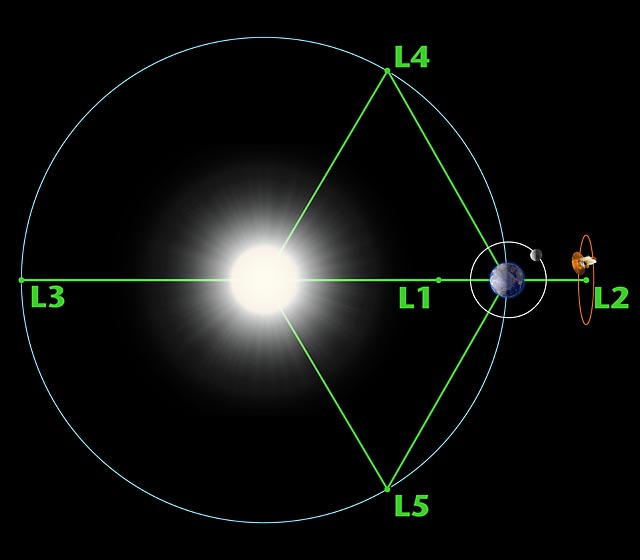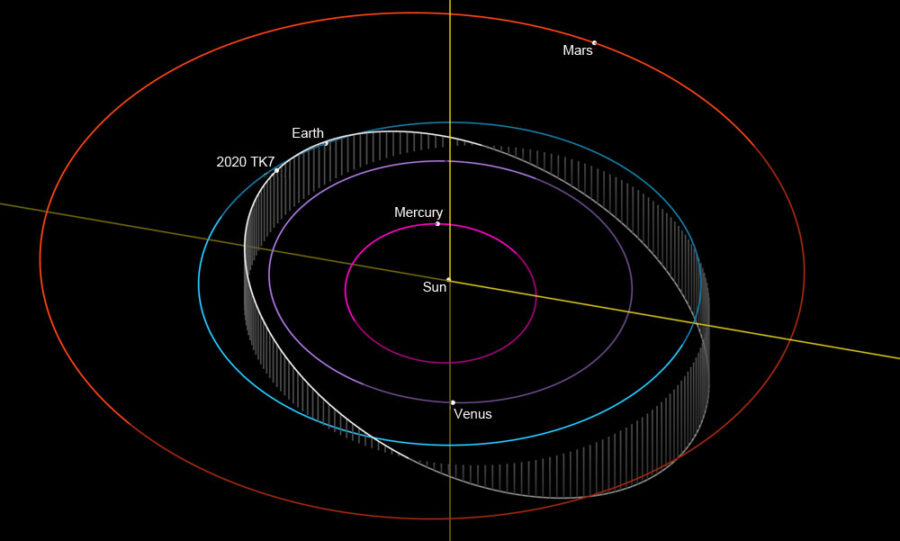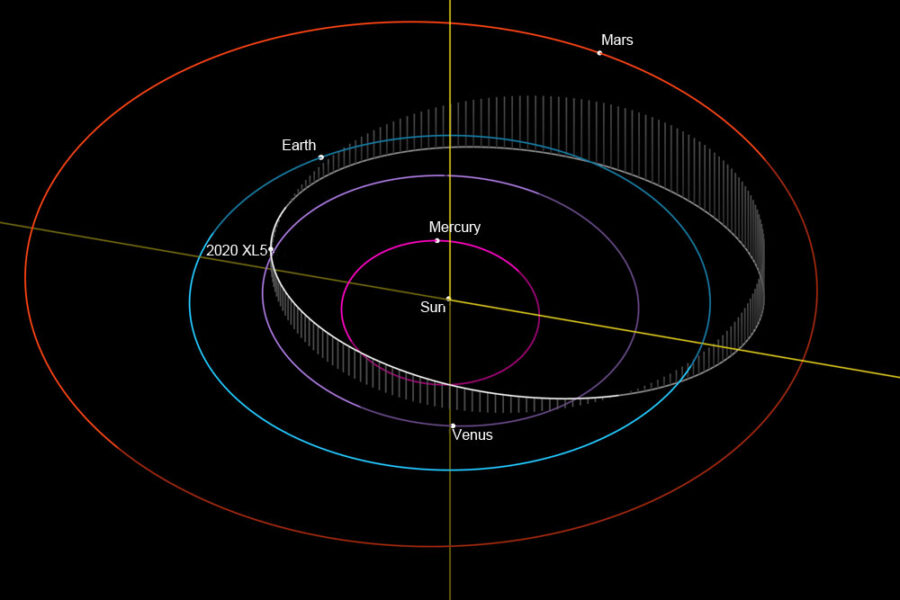A recently discovered asteroid appears to be an Earth Trojan, orbiting a gravitationally stable area with only one other known occupant.
Earth has a second Trojan asteroid sharing its orbit, reports amateur Tony Dunn on the Minor Planet Mailing List. The asteroid, dubbed 2020 XL5, is a few hundred meters across and its orbit is tied to a gravitationally stable region ahead of Earth in its orbit.

Tony Dunn
Trojans are asteroids gravitationally locked to stable Lagrange points either 60° ahead (L4) or behind (L5) the planets in their orbits around the Sun. 2020 XL5 was found around the L4 point. Massive Jupiter has more than 9,000 Trojans. In theory, Trojan orbits would be stable around every planet except Saturn, where Jupiter’s gravity pulls them away. So far, Trojans have been found sharing orbits — at least temporarily — with Neptune, Uranus, Mars, Venus, and Earth.
Earth Trojans are hard to find because during most of their orbits, they appear close to the Sun in the sky. Not only that, but the gravitational resonance does not hold them in lockstep at 60° ahead and behind of the Earth, explains Dunn. Instead, the objects trace paths around the L4 and L5 points, which are themselves moving as Earth orbits the Sun.

NASA / WMAP Science Team
NASA's Wide-field Infrared Survey Explorer spacecraft spotted the first Earth Trojan, 2010 TK7, also locked to the L4 point, in October 2010 when it scanned the infrared sky 90° from the Sun. Two other observers recovered it a few months later with the Canada-France-Hawaii Telescope. It's slightly smaller than 2020 XL5.
The orbits of our two Trojans are best visualized along with that of Earth’s and, in the case of 2020 XL5, the orbits of all the inner planets. When viewed relative to Earth, 2010 TK7 drifts between a spot close to Earth to the L3 point on the other side of the Sun from Earth, but it doesn’t pass through the L4 point. The orbit of 2020 XL5 ranges more widely, drifting inward to inside Venus’s orbit and outward almost to Mars.

JPL Small-Body Database Browser
The wide-ranging orbit shows “[2020 XL5] is almost certainly a garden-variety bit of rock that went [close to] Venus and got perturbed into an orbit with a period very close to one year,” says Bill Gray of Project Pluto.
Aldo Vitagliano, a retired Italian chemist and author of the Solex orbital software, said on the MPML that the orbit should remain stable for 2,000 to 4,000 years, but gravitational tugs would eventually move it to another orbit. So far 2020 XL5 has only been observed for only a few weeks, and amateur astronomer Sam Deen says we may have to wait until November or December until more observations can be made to pin down its orbit.
The first Earth trojan, 2010 TK7, comes within 20 million kilometers (12 million miles) to Earth every few hundred years; it is currently drifting away. Models show its orbit is stable enough to stay in a one-to-one resonance with Earth for about a quarter million years. While there are Earth Trojan orbits that are stable for the life of the solar system, no objects have been found occupying them.

JPL Small-Body Database Browser
Two spacecraft on their way to visit near-Earth objects searched Trojan regions in 2017, but NASA's Osiris-Rex found nothing at L4 and the Japanese Hayabusa 2 found nothing at L5. However, the observations were not definitive, and in 2019 Renu Malhotra (University of Arizona) wrote that the Earth could still have up to several hundred Trojans at least a few hundred meters in diameter, amounting to several percent of the some 10,000 near-Earth objects of that size.
A population of Earth Trojans should have survived since the planet formed if its orbit hasn’t changed since then, she says. Their existence — or lack thereof — has other implications, too. Searching for ancient Trojans could help explain why the leading hemisphere of the Moon has about 70% more young craters than the trailing side, a difference current models can’t explain. Earth Trojans slowly escaping from their orbits might account for the extra young craters.
Now, Malhotra says, astronomers are stepping up their search for Earth Trojans. The Catalina Sky Survey has expanded the area it covers, and a group at the Vera C. Rubin Observatory is also planning observations once that observatory comes online in a year or two.
 11
11








Comments
PilgrimUS
February 4, 2021 at 9:47 pm
This looks like a good place to set a habitable gateway for Earth - Mars / Mars - Earth travel.
Just a thought..
You must be logged in to post a comment.
Alain Maury
February 8, 2021 at 5:06 pm
Not with that inclination. Costs a lot of energy to get out of the solar system plane. Plus we don't need to pollute the solar system, the only reason for going to Mars is to make a selfie with a flag in the background (be it chinese or USA) to show that you have the best technology. In any case does it mean that the people in your country have the best condition of life.
You must be logged in to post a comment.
John-Murrell
February 6, 2021 at 6:04 am
If this is correct ac cording to the IAU definition the Earth has failed to clear it's orbit and is no longer a planet - is it a dwarf planet now and should ? we start producing stickers for all the books that mention the Earth as a planet ?
You must be logged in to post a comment.
Yaron Sheffer
February 6, 2021 at 12:58 pm
Sorry, this joke is no longer funny. "Clearing the orbit" means removing other objects of similar size to Earth, which of course happened a long time ago. Lots of tiny debris particles still remain all over the place, even next to Jupiter, which I hope you will not start doubting the planetary status thereof.
You must be logged in to post a comment.
John-Murrell
February 6, 2021 at 2:55 pm
There is no definition of the mass of the objects that have to be cleared in the IAU definition which is as follows:
The IAU members gathered at the 2006 General Assembly agreed that a “planet” is defined as a celestial body that (a) is in orbit around the Sun, (b) has sufficient mass for its self-gravity to overcome rigid body forces so that it assumes a hydrostatic equilibrium (nearly round) shape, and (c) has cleared the neighbourhood around its orbit.
You must be logged in to post a comment.
stuartnlevy
February 6, 2021 at 7:58 pm
Steven Soter of the American Museum of Natural History (and one of the writers of Carl Sagan's Cosmos series) wrote a 2006 paper (before the IAU meeting), called What is a planet? You can read it: https://arxiv.org/abs/astro-ph/0608359 (see the Download PDF link).
It notes that, if you compare the masses of each of the solar-system planets with the masses of the things that roughly share their orbits, there is an *enormous* gap in the distribution of that "how completely has this body cleared its neighborhood" ratio. Pluto was on the wrong side of the gap, along with the asteroids and with other Kuiper Belt objects. Before reading that, I'd thought that calling Pluto a non-planet was some sort of publicity stunt. After reading it, I think this makes very reasonable basis for a definition, even without a specific mass-ratio threshold. But of course planetary geologists have their own good reasons for considering Pluto to be a planet, regardless of orbital dynamics.
(Also, whether Pluto is called a planet or not, it's obviously there, and obviously important!)
You must be logged in to post a comment.
Yaron Sheffer
February 7, 2021 at 5:49 pm
Hmmm... then they should go back and make their definition more precise 🙂
I am trying to be logical. When planetesimals combine to make a planet, any leftover bodies will be appreciably smaller. But they should be in neighboring (parallel) orbits, unlike this recent Trojan, which keeps its distance from Earth and can visit other planets as well. If it were flying next to our planet, Earth could easily clear it...
You must be logged in to post a comment.
Andrew James
February 7, 2021 at 10:57 pm
"Hmmm... then they should go back and make their definition more precise"
They say : "The IAU Style Manual Sec. 5.25 lists the names of the "principal planets" as Mercury, Venus, Earth, Mars, Jupiter, Saturn, Uranus, Neptune, and Pluto.." See link below.
You must be logged in to post a comment.
Andrew James
February 7, 2021 at 10:52 pm
No. "2006: IAU Resolution B5 (Definition of a Planet in the Solar System) explicitly lists the eight planets Mercury, Venus, Earth, Mars, Jupiter, Saturn, Uranus, and Neptune. While Resolution B5 defined the category of dwarf planet, Resolution B6 explicitly lists Pluto as an example.". https://www.iau.org/public/themes/naming/
You must be logged in to post a comment.
bsmith3544
February 7, 2021 at 4:26 pm
In the S&T diagram, L3 is placed on the opposite side of the sun at a distance equal to the earth-sun distance - that is, on the earth's orbit. But other diagrams place L3 on the opposite side of the sun, closer to the sun that the earth-sun distance -- inside of earth's orbit. See for example
http://hyperphysics.phy-astr.gsu.edu/hbase/Mechanics/lagptsolar.html
Can you please clarify? Which is correct?
You must be logged in to post a comment.
Yaron Sheffer
February 7, 2021 at 5:53 pm
I'm sure you are correct. Your link shows a very sophisticated diagram, which must be closer to the Truth. The diagram here, courtesy NASA (not S&T) is very schematic and, as you figured out, not very accurate.
You must be logged in to post a comment.
You must be logged in to post a comment.